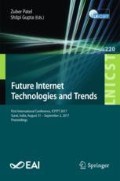Abstract
This correspondence presents the spectral efficiency analysis of 2 × 2 and 4 × 4 multiple input multiple output (MIMO) system. Analysis in this article has been done over Nakagami-m and Rayleigh fading channel. In this work analytical model as well as simulation has been observed for spectral efficiency of MIMO system over fading environment with an aid of Singular Value Decomposition (SVD) and waterfilling algorithm. It has also been observed the performance of Nakagami-m channel probabilistic model which one-to-one aligning between Nakagami-m and Rayleigh fading distributions in MIMO system.
Access this chapter
Tax calculation will be finalised at checkout
Purchases are for personal use only
References
Hasan, M.I., Kumar, S.: Spectral efficiency of dual diversity selection combining schemes under correlated Nakagami-0.5 fading with unequal average received SNR. Telecommun. Syst. 64, 3–16 (2016)
Dholakia, P.M., Kumar, S., Vithalani, C.H.: Performance analysis of 4 × 4 and 8 × 8 MIMO system, to achieve higher spectral efficiency in Rayleigh & Rician fading distributions. Wirel. Pers. Commun. Int. J. 79, 687–701 (2014)
Proakis, J.G.: Digital Communications, 4th edn. Mc Graw-Hill, New York (2001)
Goldsmith, A., Jafar, A., Jindal, N., Vishwanath, S.: Capacity limits of MIMO channels. IEEE J. Sel. Areas Commun. 21(5), 684–702 (2003)
Heath, R.W., Larsson, E.G., Murch, R., Nehorai, A., Uysal, M.: Special issue: Multiple-Input Multiple-Output (MIMO) Communications. Wirel. Commun. Mob. Comput 4, 693–696 (2004)
Alamouti, S.M.: A simple transmit diversity technique for wireless communications. IEEE J. Sel. Areas Commun. 16(5), 1451–1458 (1998)
Tse, D., Viswannath, P.: Fundamental of Wireless Communication. Cambridge University Press, Cambridge (2005)
Paulraj, A.J., Gore, D.A., Nabar, R.U., Bolcskei, H.: An overview of MIMO communications—a key to gigabit wireless. Proc. IEEE 92, 198–218 (2004)
Rouffet, D., Kerboeuf, S., Cai, L., Capdevielle, V.: A technical paper on, “4G MOBILE”. Alcatel Telecommunication Review, pp. 1–7 (2005)
Prasad, R.: Universal Wireless Personal Communication. Artech House, Norwood (1998)
Tranter, W.H., Shanmugan, K.S., Rappaport, T.S., Kosbar, K.L.: Principles of Communication System Simulation with Wireless Applications. Prentice Hall Professional Technical Reference, Upper Saddle River (2003)
Beaulieu, N.C., Cheng, C.: Efficient Nakagami-m fading channel simulation. IEEE Trans. Veh. Technol. 54(2), 413–424 (2005)
Fraidenraich, G., Leveque, O.: On the MIMO channel capacity for the Nakagami-m channel. IEEE Trans. Inf. Theory 54, 3752–3757 (2008)
Kumar, S., Pandey, A.: Random matrix model for Nakagami-Hoyt Fading. IEEE Trans. Inf. Theory 56, 2360–2372 (2010)
Basnayaka, D.A., Di Renzo, M., Haas, H.: Massive but few active MIMO. IEEE Trans. Veh. Technol. 65, 6861–6877 (2016)
Author information
Authors and Affiliations
Corresponding author
Editor information
Editors and Affiliations
Rights and permissions
Copyright information
© 2018 ICST Institute for Computer Sciences, Social Informatics and Telecommunications Engineering
About this paper
Cite this paper
Solanki, M.S., Gupta, S. (2018). Performance Analysis of Nakagami and Rayleigh Fading for 2 × 2 and 4 × 4 MIMO Channel with Spatial Multiplexing. In: Patel, Z., Gupta, S. (eds) Future Internet Technologies and Trends. ICFITT 2017. Lecture Notes of the Institute for Computer Sciences, Social Informatics and Telecommunications Engineering, vol 220. Springer, Cham. https://doi.org/10.1007/978-3-319-73712-6_27
Download citation
DOI: https://doi.org/10.1007/978-3-319-73712-6_27
Published:
Publisher Name: Springer, Cham
Print ISBN: 978-3-319-73711-9
Online ISBN: 978-3-319-73712-6
eBook Packages: Computer ScienceComputer Science (R0)

